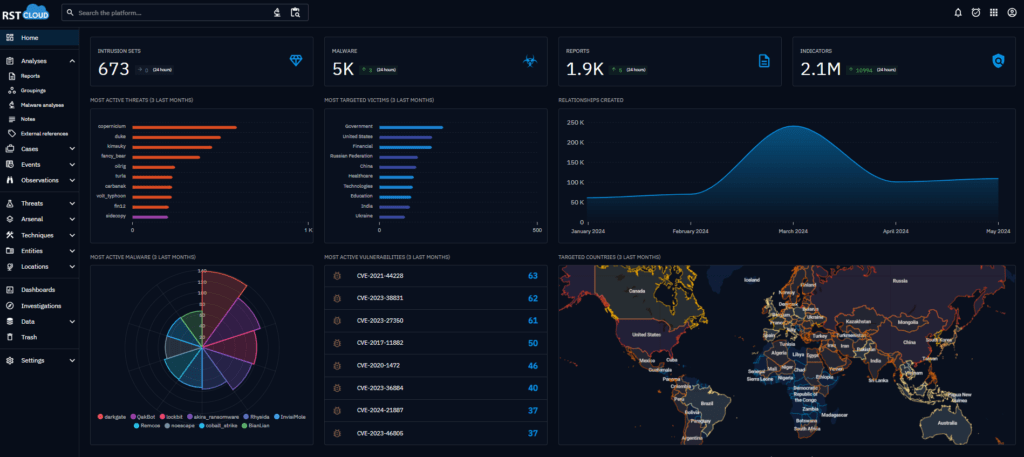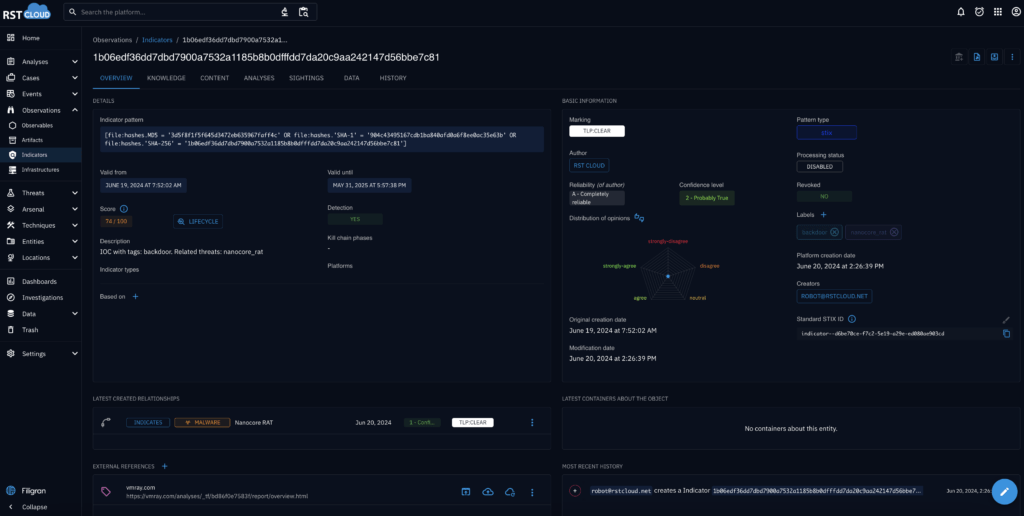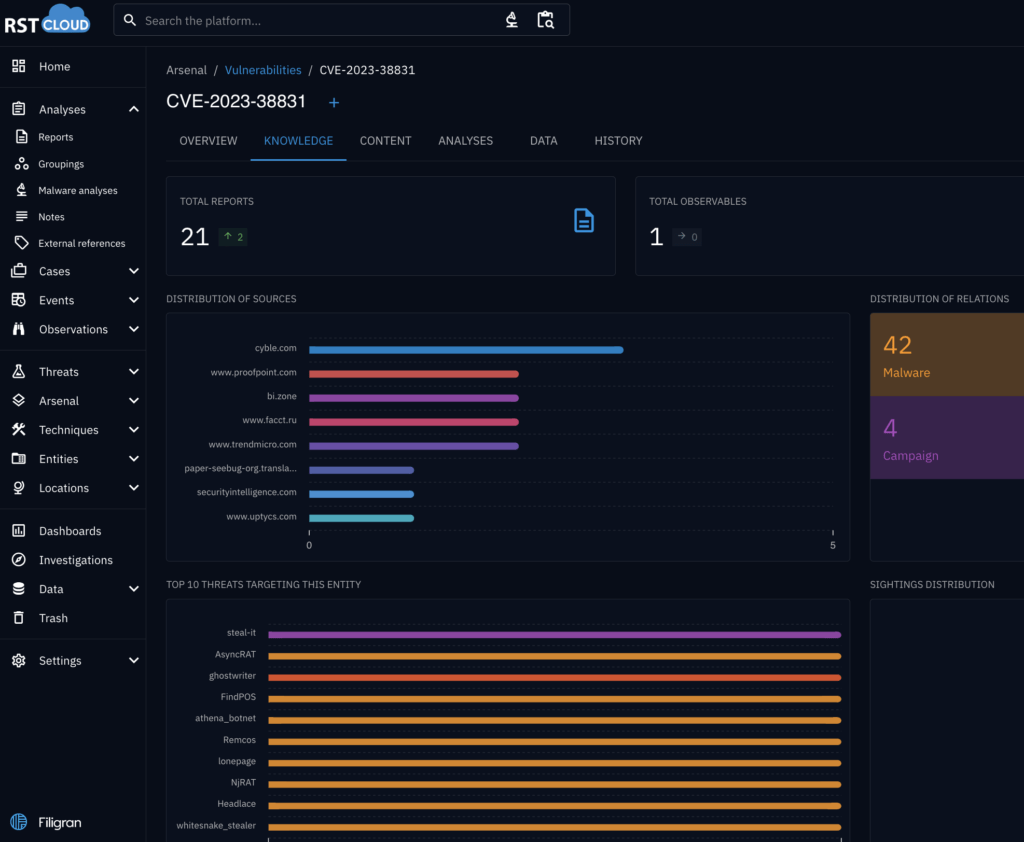
Threat Profiling with OpenCTI and RST Cloud
Jun 20, 2024
The complexity and sophistication of cyber threats are among the main pain points for many organisations worldwide. As the cyber threat landscape changes daily with new vulnerabilities being found, new tactics and techniques used by threat actors, and new malware emerging, it is crucial to have the threat profiling process automated. By leveraging advanced tools like OpenCTI and integrating data from RST Cloud, organisations can gain deeper insights into potential threats and bolster their defensive strategies. This article explores how threat profiling can be enhanced using OpenCTI and RST Cloud data.
What is Threat Profiling?
Threat profiling involves the identification, analysis, and categorisation of cyber threats. This process helps organisations understand the nature of threats they face, including the tactics, techniques, and procedures (TTPs) used by adversaries. Effective threat profiling allows for proactive defense measures, improved incident response, and strategic planning.
OpenCTI (Open Cyber Threat Intelligence) is an open-source platform designed to manage, analyse, and share cyber threat intelligence. It provides a unified environment where organisations can collect and enrich threat data from various sources, create detailed threat profiles, and facilitate collaboration.
Key Features of OpenCTI:
- Data Integration: Supports the integration of multiple threat intelligence sources, providing a holistic view of the threat landscape.
- Data Enrichment: Enhances raw threat data with contextual information, making it more actionable.
- Visualization Tools: Offers powerful visualisation capabilities to help analysts understand and communicate threat information effectively.
- Collaboration: Enables sharing of threat intelligence across teams and organisations, fostering a collaborative defense approach.
Threat Profiling with RST Cloud Data
RST Cloud is a robust cloud platform that provides comprehensive threat intelligence data and analytics. By integrating RST Cloud data with OpenCTI, organisations can significantly enhance their threat profiling capabilities.
Benefits of RST Cloud Data:
- Extensive Threat Intelligence Data: RST Cloud provides a vast repository of threat intelligence, including knowledge on threat actors, malware, tools, TTPs, vulnerabilities, indicators of compromise (IOCs), extensive threat reports library and more.
- Prompt Updates: Offers continuous threat intelligence updates, ensuring that organisations are always aware of the latest threats.
- Comprehensive Contextual Analysis: Delivers contextual analysis of threats, helping organisations understand the relevance and potential impact on their specific environment.
Combining OpenCTI and RST Cloud Data
When combined, OpenCTI and RST Cloud data provide a powerful solution for threat profiling. Here’s how organisations can leverage this integration:
Data Aggregation: use OpenCTI connectors to aggregate data from RST Cloud along with other threat intelligence sources. This creates a comprehensive threat repository.

Threat Analysis: enrich the aggregated data with contextual information from RST Cloud. This includes understanding the TTPs used by threat actors, potential targets, and attack vectors.

Threat Visualisation: utilise OpenCTI’s visualisation tools to map out threat relationships provided by RST Cloud and visualise attack patterns. This helps in identifying trends and potential attack scenarios.

Prioritisation and Response: Use the enriched threat profiles to prioritise threats and vulnerabilities based on their relevance and potential impact. This ensures that resources are allocated effectively to mitigate the most significant risks.

Collaboration and Sharing: share the threat profiles and intelligence with relevant stakeholders within and outside the organisation. This collaborative approach enhances collective defence efforts.
Case Study: Effective Threat Profiling in Action
Consider a financial institution facing a surge in cyber threats targeting its online banking services. By integrating OpenCTI with RST Cloud data, the institution can:
- Identify Threat Actors: Profile the adversaries targeting the financial sector and understand their TTPs.
- Enrich IOC Data: Enhance IOCs with contextual information from RST Cloud, such as associated malware and command-and-control (C2) infrastructure.
- Visualise Attack Patterns: Use OpenCTI to visualise how threats are evolving and identify potential vulnerabilities in their systems.
- Prioritise Defences: Focus on high-priority threats that pose the greatest risk, such as those exploiting newly discovered vulnerabilities.
- Collaborate with Peers: Share threat intelligence with other financial institutions and industry bodies to strengthen overall security posture.
Conclusions
Threat profiling is a critical component of modern cybersecurity strategies. By leveraging the capabilities of OpenCTI and integrating comprehensive data from RST Cloud, organisations can significantly enhance their ability to identify, analyse, and respond to threats. This integrated approach ensures a proactive and informed defense strategy, ultimately helping to safeguard critical assets and maintain organisational resilience in the face of evolving cyber threats.
To get RST Cloud for OpenCTI – please contact us!